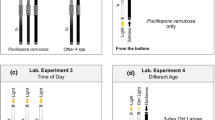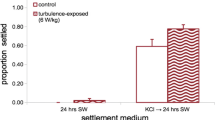Abstract
Individuals of some benthic species swim out of or away from the sediment surface into the water column, i.e., they emerge. Individuals of both emergent and nonemergent benthic species can be entrained by near-bottom flows. Both emergence and entrainment are of interest, e.g., for their roles in benthopelagic coupling, but the controlling factors are poorly understood. Our experiments with benthic copepods from contrasting environments showed that a factor (or factors) associated with the onset of darkness, rather than an endogenous rhythm, controls their dusk emergence. In addition, we argue that entrainment and emergence can interact in at least two ways: (1) Light-induced changes in oxygenation of the sediment pore water may affect the entrainment flux of benthic copepods and (2) if large numbers of individuals are entrained in the time leading up to sunset, few will remain in the sediment to be part of the dusk peak in emergence.









Similar content being viewed by others
References
Armonies, W. 1988a. Active emergence of meiofauna from intertidal sediment. Marine Ecology Progress Series 43: 151–159.
Armonies, W. 1988b. Physical factors influencing active emergence of meiofauna from boreal intertidal sediment. Marine Ecology Progress Series 49: 277–286.
Armonies, W. 1994. Drifting meio- and macrobenthic invertebrates on tidal flats in Königshafen: A review. Helgolander Meeresuntersuchungen 48: 299–320.
Broecker, W.S., and T.H. Peng. 1974. Gas exchange rates between air and sea. Tellus 26: 185–190.
Buffan-Dubau, E., and J. Castel. 1996. Diel and seasonal vertical distribution of meiobenthic copepods in muddy sediments of a eutrophic lagoon (fishponds of Arcachon Bay). Hydrobiologia 329: 69–78.
Chandler, G.T., and J.W. Fleeger. 1983. Meiofaunal colonization of azoic estuarine sediment in Louisiana: Mechanisms of dispersal. Journal of Experimental Marine Biology and Ecology 69: 175–188.
Cohen, J.H., and R.B. Forward Jr. 2002. Spectral sensitivity of vertically migrating marine copepods. The Biological Bulletin 203: 307–314.
Cohen, J.H., and R.B. Forward Jr. 2005. Diel vertical migration of the marine copepod Calanopia americana II. Proximate role of exogenous light cues and endogenous rhythms. Marine Biology 147: 399–410.
Cubit, J. 1969. Behavior and physical factors causing migration and aggregation of the sand crab Emerita analoga (Stimpson). Ecology 50: 118–123.
Foy, M.S., and D. Thistle. 1991. On the vertical distribution of a benthic harpacticoid copepod: Field, laboratory, and flume results. Journal of Experimental Marine Biology and Ecology 153: 153–163.
Hicks, G.R.F. 1986. Distribution and behaviour of meiofaunal copepods inside and outside seagrass beds. Marine Ecology Progress Series 31: 159–170.
Jeroschewski, P., C. Steuckart, and M. Kühl. 1996. An amperometric microsensor for the determination of H2S in aquatic environments. Analytical Chemistry 68: 4351–4357.
Jørgensen, B.B., and N.P. Revsbech. 1985. Diffusive boundary layers and the oxygen uptake of sediments and detritus. Limnology and Oceanography 30: 111–123.
Li, Y.H., and S. Gregory. 1974. Diffusion of ions in sea water and in deep-sea sediments. Geochimica et Cosmochimica Acta 38: 703–714.
Palmer, M.A. 1984. Invertebrate drift: Behavioral experiments with intertidal meiobenthos. Marine Behaviour and Physiology 10: 235–253.
Palmer, M.A. 1988. Dispersal of marine meiofauna: A review and conceptual model explaining passive transport and active emergence with implications for recruitment. Marine Ecology Progress Series 48: 81–91.
Palmer, M.A., and R.R. Brandt. 1981. Tidal variation in sediment densities of marine benthic copepods. Marine Ecology Progress Series 4: 207–212.
Revsbech, N.P. 1989. An oxygen microelectrode with a guard cathode. Limnology and Oceanography 34: 472–476.
Service, S.K., and S.S. Bell. 1987. Density-influenced active dispersal of harpacticoid copepods. Journal of Experimental Marine Biology and Ecology 114: 49–62.
Teasdale, M., K. Vopel, and D. Thistle. 2004. The timing of benthic copepod emergence. Limnology and Oceanography 49: 884–889.
Thistle, D., G.L. Weatherly, and S.C. Ertman. 1995. Shelf harpacticoid copepods do not escape into the seabed during winter storms. Journal of Marine Research 53: 847–863.
Thistle, D., L. Sedlacek, K.R. Carman, J.W. Fleeger, and J.P. Barry. 2007. Emergence in the deep sea: Evidence from harpacticoid copepods. Deep-Sea Research I 54: 1008–1014.
Trüper, H.G., and H.G. Schlegel. 1964. Sulphur metabolism in Thiorhodaceae 1 Qualitative measurements in growing cultures of Chromatium okenii. Antonie van Leeuwenhoek 30: 225–238.
Van Gemerden, H., C.S. Tughan, R. De Wit, and R.A. Herbert. 1989. Laminated microbial ecosystems on sheltered beaches in Scapa Flow, Orkney Island. FEMS Microbiology Ecology 62: 87–102.
Visscher, P.T., J. Beukema, and H. Van Gemerden. 1991. In situ characterization of sediments: Measurements of oxygen and sulfide profiles with a novel combined needle electrode. Limnology and Oceanography 36: 1476–1480.
Vopel, K., J. Dehmlow, and G. Arlt. 1996. Vertical distribution of Cletocamptus confluens (Copepoda, Harpacticoida) in relation to oxygen and sulphide microprofiles of a brackish water sulphuretum. Marine Ecology Progress Series 141: 129–137.
Walters, K. 1988. Diel vertical migration of sediment-associated meiofauna in subtropical sand and seagrass habitats. Journal of Experimental Marine Biology and Ecology 117: 169–186.
Walters, K. 1991. Influences of abundance, behavior, species composition, and ontogenetic stage on active emergence of meiobenthic copepods in subtropical habitats. Marine Biology 108: 207–215.
Walters, K., and S.S. Bell. 1986. Diel patterns of active migration in seagrass meiofauna. Marine Ecology Progress Series 34: 95–103.
Acknowledgments
D. Oliff built the watertight cases for the light meter and the data logger. C. Hasemann, B. C. Hippolyte, I. Hoedl, G. Hurst, M. Pöhn, L. Sedlacek, K. Suderman, M. Teasdale, and A. Vopel helped in the laboratory or the field. The FSU Academic Diving Program provided equipment and training. The European Union Program “Training and Mobility of Researchers,” the Alfred Wegener Institute for Polar and Marine Research, the Kristineberg Marine Research Station of The Royal Swedish Academy of Science, the Klubban Biological Station of Uppsala University, the Florida State University Coastal and Marine Laboratory, and the Faculty of Health and Environmental Sciences of Auckland University of Technology provided funding and/or equipment.
Conflict of Interest
We do not have financial interests in the organizations that sponsored the research. We have full control of all primary data and agree to allow the journal to review the data if requested. No conflicts of interest exist.
Author information
Authors and Affiliations
Corresponding author
Rights and permissions
About this article
Cite this article
Vopel, K., Thistle, D. Cues, Not an Endogenous Rhythm, Control the Dusk Peak in Water-Column Entry by Benthic Copepods. Estuaries and Coasts 34, 1194–1204 (2011). https://doi.org/10.1007/s12237-011-9403-9
Received:
Revised:
Accepted:
Published:
Issue Date:
DOI: https://doi.org/10.1007/s12237-011-9403-9




